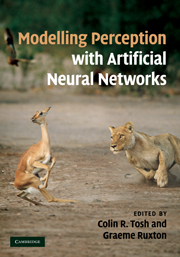
-
Select format
-
- Publisher:
- Cambridge University Press
- Publication date:
- 05 July 2011
- 24 June 2010
- ISBN:
- 9780511779145
- 9780521763950
- Dimensions:
- (247 x 174 mm)
- Weight & Pages:
- 0.94kg, 408 Pages
- Dimensions:
- Weight & Pages:
- Subjects:
- Animal Behaviour, Life Sciences, Neurosciences
You may already have access via personal or institutional login- Subjects:
- Animal Behaviour, Life Sciences, Neurosciences
Book description
Studies of the evolution of animal signals and sensory behaviour have more recently shifted from considering 'extrinsic' (environmental) determinants to 'intrinsic' (physiological) ones. The drive behind this change has been the increasing availability of neural network models. With contributions from experts in the field, this book provides a complete survey of artificial neural networks. The book opens with two broad, introductory level reviews on the themes of the book: neural networks as tools to explore the nature of perceptual mechanisms, and neural networks as models of perception in ecology and evolutionary biology. Later chapters expand on these themes and address important methodological issues when applying artificial neural networks to study perception. The final chapter provides perspective by introducing a neural processing system in a real animal. The book provides the foundations for implementing artificial neural networks, for those new to the field, along with identifying potential research areas for specialists.
Contents
Metrics
Full text views
Full text views help Loading metrics...
Loading metrics...
* Views captured on Cambridge Core between #date#. This data will be updated every 24 hours.
Usage data cannot currently be displayed.
Accessibility standard: Unknown
Why this information is here
This section outlines the accessibility features of this content - including support for screen readers, full keyboard navigation and high-contrast display options. This may not be relevant for you.
Accessibility Information
Accessibility compliance for the PDF of this book is currently unknown and may be updated in the future.


